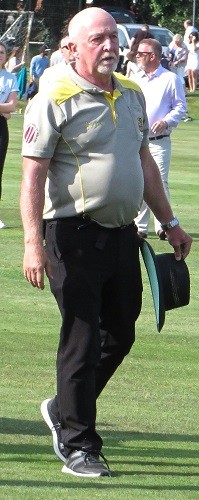
Let me take you through a whistle stop journey of my career in cricket from learning the ropes in Dundrum to International Umpire.
Where do I start?
It has to be at 1 Castle Hill Dundrum, in the shadow of the castle, my homestead for 20 years before going to the ‘Big Smoke’ for 3rd level education and employment.
The journey between home and the cricket ground is around two miles and this was ran three times a week. Twice for the senior practices and once for the junior.
At the senior practices, I, as a thirteen-year-old, was only there to field the ball for the senior players and rarely, if ever, got to bat or bowl. For those of you who know the Meadow you can imagine the experience of facing a medium bowler with a dark ball at 10pm from the river end and not showing fear, but it was a real learning curve.
Occasionally the opportunity arose to play for the 2nd X1 and that was when the real learning began and my first experience of the role of the umpire.
During a 2nd X1 match in Dundrum our resident umpire, well known for residing on a bar stool in the Bay Inn, had been persuaded to forgo an afternoon at the bar in exchange for several free glasses of cool refreshment and to wear a white coat.
Early in the match our 4th change strike bowler Jim “Malinga” Newell hit the opposing batsman somewhere in the vicinity of the stumps and appealed loudly .The initial appeal was turned down whereupon Jim shouted ‘have another look’ .The umpire then realising that good drinking time was being wasted replied ‘ Yes you’re right, that`s out ‘.
My first encounter with a white coat!
Another incident worthy of recognition was during a 2nd X1 match at Ewarts during the 1971 season. On strike was Surrindra Tohani an Asian gentleman from Warrenpoint who came to the Meadow to practice one night a week.
At the non-strikers end was Jim Malinga Newell and when Surrindra played the ball into the cover area, called ‘Yes ‘ and set off, Jim being in two minds replied ‘No Surrindra , No Surrindra’ upon which the match halted due to the infectious laughter that spread throughout the ground. The game finished early that day due to the local battalion commandeering the scorebox for their meeting!
Following a fairly successful and enjoyable season I found myself playing occasionally for the 1st X1.
At that time in the mid 70’s there were four Curletts playing for the team. Jack, Tommy, Jim and Bobby the latter had outstanding ability with the bat. When it came to throwing the bat through an open Pavilion door from 20 yards, there was no one better in the club! All four brothers are still actively involved in the week to week running and development of the club. Jeffrey Maguire, a club stalwart, has been instrumental in maintaining and developing the club over some very difficult times.
Instilled in my memory was playing with my brother, Neville and my father Tom in the Downshire Cup winning team. It was a very competitive match where Noel Maguire and myself both contributed to the win and the resulting celebrations were definitely a night to forget!
Soon after this both Neville and I moved to play for Downpatrick and were lucky enough to be involved in the 1976 and 1977 league and cup winning sides respectfully. The 1977 final was known as “Fergie`s final”. During my time with Downpatrick I had the pleasure to play with legends of the game such as Alfie and Hugh Linehan and Noel Ferguson. Real ambassadors of the game.
Travelling from Belfast to Downpatrick two nights a week to practice was proving difficult to manage and I was drawn to Cliftonville by Roy Millar. My first term with the club brought me into contact with John Solanky, one of the most knowledgeable cricketers I have ever encountered. After four seasons with Cliftonville I then joined Neville at Ballymena for three seasons playing alongside Jimmy Boyce, Dessie Kane, Adrian Goodrich and the Cook brothers.
At Ballymena we had several successful seasons which resulted in my selection to play for Ulster Country in the Guinness Cup.
With a young family and living close to Greenisland, the then home of Cliftonville, I re-joined and spent the remainder of my playing career there. During this time Cliftonville won Section 2 and under my captaincy we won three senior league titles in a row, two outright and one shared with Lisburn. Playing for Cliftonville also gave me the opportunity to play for Ulster Town.
At that time the Cliftonville team consisted of some excellent cricketers such as Kyle McCallan, Mark and Andrew Patterson and Kamal Merchant to name a few. These players along with the rest of the squad were instrumental in building a very flourishing club. Another true gentleman and professional who can`t go unmentioned was Gerald Dross who the opposition didn’t relish bowling to.
Throughout my spells at Cliftonville and Ballymena I was also involved in N.C.U. and Irish under age cricket. One trip of note, amongst many, was playing the English U-15 at Eaton college with the Irish U-17 side. We were on our way home from winning the European tournament we had been involved in, so were on a “high”. During a rain break in the match a standing umpire asked me if any of the Irish team were worth considering for county cricket. I pointed out the potential a young sandy haired 14-year-old had and that a county should become involved in his development. Shortly afterwards Middlesex got involved with him which proved very beneficial for the club, player and country Since then Eoin Morgan hasn't let anyone down.
With playing days coming to a close I looked at ways of keeping involved in the game that had been a big part of my life (beats shopping on a Saturday!) so I was encouraged to try umpiring. I then started training to achieve the various levels required in order to stand as an umpire. Not sure if I would like officiating, I combined playing and officiating for a season and found it difficult to ‘change hats’ on back to back days but by now my enjoyment of officiating was growing so I took the decision to stop playing.
Over time I got involved in the education and training side of umpiring, working with Keith Smith, who was involved both locally and also within Europe. Following Keith`s retirement from umpiring and training I took over as education and training officer for all levels within the N.C.U. I along with several colleagues present Stage 1 &2 courses regularly over the winter months. I have now found myself lead tutor for Stage 3 education for Ireland. We are constantly developing umpires with the view to improving quality and numbers.
After developing my own personal education, I found myself getting more games up the leagues and standing with some very experienced officials. My first game was with NIACUS past President Peter Lunney in a game between Instonians and Belfast Royal Academy schools in the second round of the Schools Cup. My first ever victim was Ben Clements, grandson of one of our own colleagues, Arthur Thompson, who fell stumped to a sharp decision at square leg. If the truth be told he didn’t even look over to me he was that far out of his ground.
The first senior game was at Carrick with Paddy O’Hara, a person I owe a lot to in my umpiring career. On that day I almost took the field with my casual shoes on. What a start that would have been!
Standing with and listening to Paddy gave me the drive to go forward. He was always available if a matter had to be clarified and throughout my entire career, he was instrumental in my development to which I owe him a lot.
I was fortunate to receive my first Senior Cup final appointment in 2009 and have gone on to do three more, plus three All Ireland Finals.
With my umpiring on the way upwards I was fortunate to be included in the European Development Squad which gave me the opportunity to experience cricket in different environments and with different colleagues.
My first notable experience was when I was awarded the inaugural Trevor Henry Bursary. Trevor had been an outstanding person and international umpire who sadly lost his fight against illness far too early in his career. The Bursary was set up in his memory to allow an umpire the opportunity to shadow top level umpires in everyday situations. This Bursary I am pleased to say is still going to this day.
My trip took me to Hampshire where I caught the last day of the Hampshire v Sussex match and the following day Hampshire were to play Essex in a 50 over game. I was to shadow Geoff Evans and Nigel Cowley. The former later told me that this would be his 27th consecutive day in the middle. Some achievement!
I shadowed both before the match and was included in the walk around and conversations with the ground staff before the game. Although the game was to start at 1pm due to inclement weather the start was put back and now agreed as a 30 over game.
I was standing on the steps of the pavilion fifteen minutes before the bell was to be rung, when Geoff approached me and said to me in a very broad Welsh accent ‘Ok boy you’re on’. Thinking he was joking I just smiled back however he repeated the same line and his expression had changed considerably. He then explained that Nigel had chest pains and the paramedics were working with him and I would have to take his place.
You can imagine my reaction as I followed him into the changing room to get dressed appropriately for the challenge of my career so far. He told me to borrow Nigel’s six £2 coins and we would use them later to buy a drink. Apparently, Nigel was always reluctant to do so.
The bell rang and down the steps we went. What an occasion. I gave two run out decisions, both exceptionally obvious but I was not going to miss the chance of ‘raising the finger’ on an occasion like this. Standing on the balcony afterwards reflecting on the day I recall my inner self saying that this is what it’s all about. What an incentive to keep working hard as you never know what might lie ahead. How right that was going to prove. I did get to keep Nigel’s top but I give him back his six £2 coins.
The only down side to a fantastic day was the eye-opening amount and intensity of sledging that went on in one direction from Shane Warne (captain) to a young Ravi Bopara. With Bopara facing, Warne was fielding at first slip some 25 yards back but this didn`t prevent him from engaging loudly towards Bopara. I at square leg was able to clearly hear all. At the fall of a wicket I chatted with Geoff who was fully aware of what had gone on. His summary of the situation “selective hearing is a great attribute”.
Being involved in European tournaments meant a lot of preparation, often three weeks before the event. This could be a request for a personal CV being sent to the Referee, mentor and other match colleagues so we could all learn about each other’s background and experience ,thus having a’ heads up’ before the tournament .Questions were sent from the Referee which had to be answered and returned. A personal assessment was done on each official by the Referee and mentor based from the first contact to getting on the plane to come home. It certainly wasn’t a jolly, anything but as most days began at 7.30 am and concluded after a lot of paperwork around 10pm.
On many occasions the tournament Referee was David Jukes who ran the show with precision and an absolute no nonsense approach which meant arriving two minutes late for a meeting you would have found the door closed .Although ruthless at times David instilled the importance of structure and discipline into your preparation for any game. An aspect that has held me in good stead ever since.
As previously stated via the European tournaments I have been given me the chance to see the game in a variety of countries and experience very varied playing conditions. Kicking the piles of soil back down the mole holes in the outfield in Belgium to ensure the players could run safely over it and also to prevent the ball getting lost springs to mind. Standing in 42 degrees of heat in Bologna proved very difficult but drinks breaks every 10 minutes were invaluable. The ham sandwiches which arrived early each day for the interval were best left where they had arrived in the hot brown bag. Difficult conditions to work in but a great learning experience which was just what I had signed up for!
Belgium, Italy, Holland, Spain and the Channel Islands were just a few of the places cricket took me to in the first years of being in the Development Squad.
During an early trip to Guernsey I experienced how not to act as an official. They always say you can learn more from a poor performance. The situation occurred at Port Soif. As was the case, there were three in the team. Two standing umpires and a third. Back then the third provided drinks to his colleagues, spare balls and relayed information if and when needed concerning intervals etc. During the game the presence of our third became less and less frequent and communication non-existent. This ground was very picturesque, being separated from the beach by small sand dunes. Sponsors and ECB officials often visited the matches and, on this occasion, arrived just before a drinks interval. Realising that my colleague and I had not been supplied with refreshment by our third the match Referee brought us a last-minute drink. He asked as to the whereabouts of our team member however we could throw no light on this. It transpired that whilst doing a lap of the ground and admiring the sea views the ‘blazer brigade’ noticed our third team member sunning himself in the golden sands oblivious to any cricket on the other side of the dunes and also still in possession of a bag of spare balls. I don’t recall seeing his name at any future appointments. During these trips new friendships were made and a lot of lessons learned.
One occasion in particular in La Manga Alex Dowdall, a legend in Scotland, and Charlie McIlwee another legend in the North West, formulated a plan to equip Alex with a black hat suitable for white ball cricket. After a visit to the local gift shop and purchasing a suitable wide brimmed hat and a tin of black spray paint from the nearby garage these two legends set about creating a masterpiece in the patio barbeque area. I wish I had videoed their antics!
The end result was a hat that would easily break a window if thrown against it, and also provided Alex with a neat black line across his forehead in the following match. Priceless! These two gentlemen and I had numerous adventures in Europe, each time strengthening friendships but never again attempting such DIY activities.
Having been promoted from the Development Squad to the Elite Group within Europe I often shared the company of experienced mentors such as Ian Gould and Michael Gough, the latter being involved with an Underage World Cup Qualifying Tournament in Jersey and the former leading the troops in Jersey during a WCL Div. 5 tournament.
Standing with Sue Redfern and Jacqueline Williams in WCL5 and European Division Qualifying Division 2 was interesting and since then both have developed into outstanding international umpires.
The structure of the European panels was made up from countries around the world which resulted in new conditions for some. Understandably the Scots and Irish became mentors with regards to rain as some of our colleagues had never experienced these conditions before and this resulted in a steep learning curve for some although all benefitted from the experience. The tournaments continued to become of a higher standard and the challenges greater.
Most umpires when asked about their most difficult decisions would mention a glance down the leg side, or a delivery that cuts back through the batsman, clipping “who knows what” on the way through to the keeper. When I was asked recently I didn`t hesitate to recall a situation in a European T20 final under lights at Hove between Italy and Denmark. My colleague on that occasion was fellow N.I.A.C.U.&S. member Richard Smith. Jersey and Guernsey had both been beaten in the semi-finals earlier, but come final time, a well lubricated crowd created an excellent atmosphere.
Denmark in red were batting, Italy in blue fielding. I`m at square to a left-handed batsman and the stage of the game is 23/0 in 5.2 overs. I notice a slight field change. A fielder at deep extra cover, a fielder at long off, so far so good, but glancing over my right shoulder I notice another blue shirt. Not good!!!.In the time it takes the bowler to run 20 yards towards the wicket I have counted 8 fielders inside the fielding circle 5 times. As he delivers the ball, I call NO BALL! And everyone looks in my direction. The wicketkeeper calls over “what for umps?”. I dug deep for air and in a slightly high-pitched voice I reply “fielding infringement”. I then pointed to deep extra cover, then to long off, and now I`m praying that what I saw earlier at deep square leg was a fielder and not a spectator in a blue shirt carrying 4 beers in a cardboard carrier. Thankfully it was a fielder. Give me a difficult L.B.W any day.
I have already mentioned earlier the role of the third umpire but now that role has changed considerably.
It now consists of: -
- Keeping a ball to ball record of the match.
- Noting stoppages and the reasons.
- Recording allowances.
- Calculating new rates.
- Ball selection at the toss.
- Spare balls.
- Team sheets for managers.
- Recording bowlers’ overs.
- Umpire assessments from captains and self-assessment sheets for umpires
A far cry from sunbathing in Guernsey!
When a certain Mr Michael Gough took on this role in the underage tournament, he openly admitted that he had never worked so hard during a cricket match in his career.
Moving from Elite in Europe to the A&A group of umpires brought me into the realms of top-level matches.
Around this time, I witnessed one of the best exhibitions of fast bowling I have ever had the joy to officiate. Ireland v South Africa “A” in Wicklow. The bowler hands me his sweater and hat and informs me “left arm over.” I pass the information to the batsman and the bowler goes back to his run up. As he passes me, I put my usual routine into practice, -slight glance down to check front foot and then focus on the business end. Only this time when I changed focus to the business end the ball had passed the batsman and was on its way to the keeper. I recall saying to myself “Alan get your A game quick”. Over the space of two spells, each of 5 overs and a field set which consisted of, four slips, two gullies and a short square leg the bowler claimed seven Irish victims. One delivery in particular which was fended off an inch before the helmet grill was caught at deep fine leg. On this occasion the batsman had a slightly relieved look on this face on his way back to the pavilion. The bowler, Wayne Parnell, completed an outstanding exhibition of pace bowling and also went on to take another five for in his next match.
Having been in Europe with the match referee David Jukes it came as no surprise to me to be asked to keep a ball by ball record in a four-day Intercontinental Cup game at Stormont. I lost the will to live several times throughout that match and any expenses I earned for that match went on paracetamol.
I continued to get the opportunity to share ideas and techniques with experienced umpires from around the world, Sean George from South Africa and Gregory Braithwaite from West Indies to name a few. Even bigger names were to arrive from 2016 onwards.
With Test status being granted in 2016 it opened doors for Test playing nations to visit Ireland and for the International panel of Ireland Mark Hawthorne, Roly Black, Paul Reynolds and myself to gain experience and develop techniques from the world’s best umpires. This promotion to the international stage brought us into contact with Denis Burns who was the umpire manager/coach for a large group of umpires worldwide. This was a completely new aspect of the game for us. He is always present to give assistance at all fixtures in Ireland and continues on a weekly basis now with training and simulation for 3rd umpire work. Opening the door to the top table gave us the opportunity to work with instead of just watching the top officials in our game. I have had the pleasure of working with the Elite panel on several occasions in high profile matches and always enjoyed these experiences.
With Test status bringing other Test nations to our shores the opportunity to stand with the world’s best presented itself. Standing with Aleem Dar, Ian Gould and Richard Kettleborough gave me the chance to compare and contrast differing umpiring styles. I can’t think of two more contrasting approaches than Gould and Dar.
If not in the middle with such names then I often found myself in front of a tv monitor reviewing decisions or live calls. Sitting alongside Jeff Crowe, David Boon or Ranjan Madugalle took a lot of getting used to. Listening was always the best policy.
Over the past four years nearly all the Test nations have visited and provide stiff opposition for the Irish teams in all forms of the game both in men’s and woman’s cricket.
Two fixtures in particular within woman’s cricket stand out for me.
Ireland v Bangladesh at Shaw’s Bridge where I gave a hat trick of LBWs. Fortunately, technology was available and on self-review all three were correct- in my opinion! The other match was Ireland v NZ at Dublin YMCA in 2018 whereupon NZ posted 491-4 in 50 overs which turned out to be a record total in all forms of 50 over cricket. Arms were sore that night.
Fortunately, with regards to highs and lows in the men’s games only one low comes to mind. That was at Stormont when Ireland played Afghanistan and illegal fielding spoiled the entire day. It resulted in Ed Joyce being conned into thinking he had scored a boundary 4 whereupon the ball was returned and wickets broken with him chatting to William Porterfield mid pitch. Later photographic evidence showed clearly the misdemeanour by the fielder.
The highs come in two forms;
Firstly, being appointed to the team for the inaugural Test match at Malahide and working alongside Chris Broad, Nigel Long as well as Richard Illingworth who is 2019/20 No 1 world umpire. The whole occasion was one I will never forget. Mark was TV umpire that day and did a fine job.
The second was being in the middle with Roly Black for Ireland v India T20 I. Did I ever imagine that I would be giving Virat Kohli and MS Dhoni guard at Malahide with nine thousand very noisy Indian spectators in attendance? A year earlier in the National Stadium Dubai during a T20 final between Ireland and Afghanistan 14 thousand spectators had created an awesome atmosphere. Due to the noise that day in Malahide, I was unable to hear Kohli asking for guard so a lot of pointing took place.
These matches along with various tri-series events involving Bangladesh, West Indies and Ireland as well as New Zealand, Bangladesh and Ireland will live long in my memory.
I recalled earlier how the bar had moved from my initial goal to be appointed to tournaments in Europe some 20 years ago, however after 115 international matches in the middle, 8 ODIs and 15 T20 International matches I often reflect on how lucky I have been.
Throughout this whistle stop account of my journey I have only scratched the surface of the different episodes. Perhaps at the right time, in the right place and in the correct company I may expand on some.
Many thanks to all such as, Paddy O’Hara, David Jukes, Denis Burns and recently my three International colleagues who have helped and continue to help along the way-but without the help and support of my wife of 38 years I would never have achieved my current level of success(hard work and a sprinkle of luck also go a long way)
A brief note to finish on.
Whilst in the 3rd umpires’ room and watching a colleague reviewing a decision that the “on field officials” had asked for clarification on, I heard another umpire say “Have another look”.
Now where had I heard that before?
Oh yes in the Meadow 50 years earlier!








